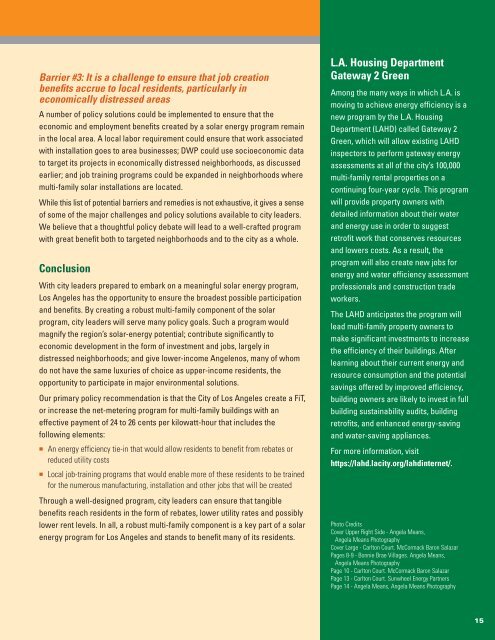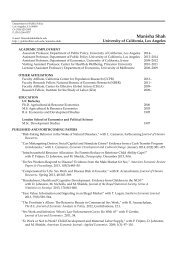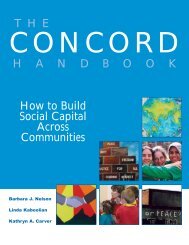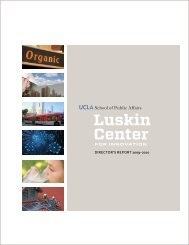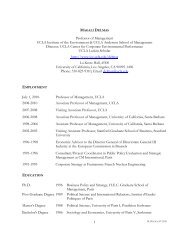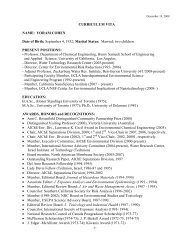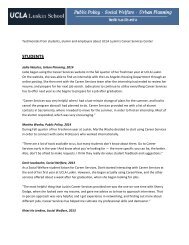Making a Market Executive Summary.pdf - UCLA Luskin School of ...
Making a Market Executive Summary.pdf - UCLA Luskin School of ...
Making a Market Executive Summary.pdf - UCLA Luskin School of ...
Create successful ePaper yourself
Turn your PDF publications into a flip-book with our unique Google optimized e-Paper software.
Barrier #3: It is a challenge to ensure that job creation<br />
benefits accrue to local residents, particularly in<br />
economically distressed areas<br />
A number <strong>of</strong> policy solutions could be implemented to ensure that the<br />
economic and employment benefits created by a solar energy program remain<br />
in the local area. A local labor requirement could ensure that work associated<br />
with installation goes to area businesses; DWP could use socioeconomic data<br />
to target its projects in economically distressed neighborhoods, as discussed<br />
earlier; and job training programs could be expanded in neighborhoods where<br />
multi-family solar installations are located.<br />
While this list <strong>of</strong> potential barriers and remedies is not exhaustive, it gives a sense<br />
<strong>of</strong> some <strong>of</strong> the major challenges and policy solutions available to city leaders.<br />
We believe that a thoughtful policy debate will lead to a well-crafted program<br />
with great benefit both to targeted neighborhoods and to the city as a whole.<br />
Conclusion<br />
With city leaders prepared to embark on a meaningful solar energy program,<br />
Los Angeles has the opportunity to ensure the broadest possible participation<br />
and benefits. By creating a robust multi-family component <strong>of</strong> the solar<br />
program, city leaders will serve many policy goals. Such a program would<br />
magnify the region’s solar-energy potential; contribute significantly to<br />
economic development in the form <strong>of</strong> investment and jobs, largely in<br />
distressed neighborhoods; and give lower-income Angelenos, many <strong>of</strong> whom<br />
do not have the same luxuries <strong>of</strong> choice as upper-income residents, the<br />
opportunity to participate in major environmental solutions.<br />
Our primary policy recommendation is that the City <strong>of</strong> Los Angeles create a FiT,<br />
or increase the net-metering program for multi-family buildings with an<br />
effective payment <strong>of</strong> 24 to 26 cents per kilowatt-hour that includes the<br />
following elements:<br />
An energy efficiency tie-in that would allow residents to benefit from rebates or<br />
reduced utility costs<br />
<br />
Local job-training programs that would enable more <strong>of</strong> these residents to be trained<br />
for the numerous manufacturing, installation and other jobs that will be created<br />
Through a well-designed program, city leaders can ensure that tangible<br />
benefits reach residents in the form <strong>of</strong> rebates, lower utility rates and possibly<br />
lower rent levels. In all, a robust multi-family component is a key part <strong>of</strong> a solar<br />
energy program for Los Angeles and stands to benefit many <strong>of</strong> its residents.<br />
L.A. Housing Department<br />
Gateway 2 Green<br />
Among the many ways in which L.A. is<br />
moving to achieve energy efficiency is a<br />
new program by the L.A. Housing<br />
Department (LAHD) called Gateway 2<br />
Green, which will allow existing LAHD<br />
inspectors to perform gateway energy<br />
assessments at all <strong>of</strong> the city’s 100,000<br />
multi-family rental properties on a<br />
continuing four-year cycle. This program<br />
will provide property owners with<br />
detailed information about their water<br />
and energy use in order to suggest<br />
retr<strong>of</strong>it work that conserves resources<br />
and lowers costs. As a result, the<br />
program will also create new jobs for<br />
energy and water efficiency assessment<br />
pr<strong>of</strong>essionals and construction trade<br />
workers.<br />
The LAHD anticipates the program will<br />
lead multi-family property owners to<br />
make significant investments to increase<br />
the efficiency <strong>of</strong> their buildings. After<br />
learning about their current energy and<br />
resource consumption and the potential<br />
savings <strong>of</strong>fered by improved efficiency,<br />
building owners are likely to invest in full<br />
building sustainability audits, building<br />
retr<strong>of</strong>its, and enhanced energy-saving<br />
and water-saving appliances.<br />
For more information, visit<br />
https://lahd.lacity.org/lahdinternet/.<br />
Photo Credits<br />
Cover Upper Right Side - Angela Means,<br />
Angela Means Photography<br />
Cover Large - Carlton Court. McCormack Baron Salazar<br />
Pages 8-9 - Bonnie Brae Villages. Angela Means,<br />
Angela Means Photography<br />
Page 10 - Carlton Court. McCormack Baron Salazar<br />
Page 13 - Carlton Court. Sunwheel Energy Partners<br />
Page 14 - Angela Means, Angela Means Photography<br />
15


